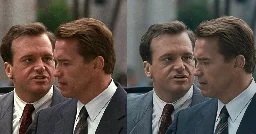Old Movies Are Being Enhanced With AI Tools and Not Everyone is Happy
Old Movies Are Being Enhanced With AI Tools and Not Everyone is Happy

Old Movies Are Being Enhanced With AI Tools and Not Everyone is Happy

The 1994 James Cameron film True Lies starring Arnold Schwarzenegger was recently re-released in Ultra HD 4K disc format giving viewers the opportunity to watch these classic films in unprecedented detail.
Not only True Lies but Cameron’s The Abyss and sci-fi classic Aliens were also released on Ultra HD Blu-ray with Geoff Burdick, senior vice president of Lightstorm Entertainment, who tells The New York Times that he thinks they “look the best they’ve ever looked.”
But not everyone agrees.
“It just looks weird, in ways that I have difficulty describing,” the journalist Chris Person tells The Times. “It’s plasticine, smooth, embossed at the edges. Skin texture doesn’t look correct. It all looks a little unreal.”
